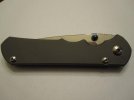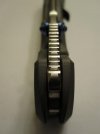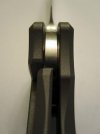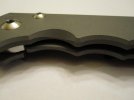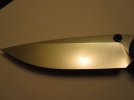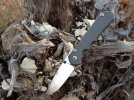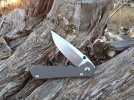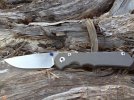Thanks guys. I did see a UTube video of take down and assembly.
http://www.youtube.com/watch?v=t9OEWoBbGKY From that it looks like the only "interference fit" is the blade stop. It is likely a bit more complex but that was my other question. The rest are just really close tolerances.
Interestingly he had some problems in the video both disassembling and assembling due to the close tolerances. The scales are terribly unforgiving of a lack of parallelism both ways. with the pins and pivot binding if not perfectly aligned. Stainless steel expands at about twice the rate of titanium with temperature increases. Since the scales are basically unconstrained, I would expect holes to enlarge with an increase in temperature. The pins and pivot, however, expand at twice the rate of the Ti holes. Without computing just how much, I don't know Chris' tolerances anyway, I would cool the parts before disassembly if problems are encountered. As your hands heat the scales, things should improve slightly. On reassembly, heating the scales slightly would help and cool the pins. A cold Allen wrench will never hurt. If you wanted to be extreme, bulk up the Allen wrenches with a good heat sink and keep it in the freezer so that it will cool the pins.
Tempest in a teapot? You bet. I don't even own one but when tolerances are really close things like different coefficients of thermal expansion must be at least considered; I'm sure Chris did.
Though purple Locktite has been recommended, I've had good success with blue even on very small parts.
The video I mentioned covered disassembly but his assembly problems were similar. He was disappointed with Chris' close tolerances when combined with his inability to maintain parallel scales. He made a good point about field stripdown maybe being a problem. I doubt it would ever be required. No judgement either way. Those tolerances don't need to be so close and he should be able to maintain parallelism. Several errors in the video but I think it was a gutsy move to do it on camera the first time .... very nice considering.
Who am I to say what would be an improvement in a fine knife but I would have eliminated the separate screw for the clip and use the rear standoff screw. This would eliminate one screw and the hot spot from the clip. The clip would have to be redesigned slightly and the screw would have to be the right length to work with or without the clip. That or a filler supplied like in the 21. If I redesigned the clip, I'd use one that doubles over itself to ride far lower even if it required a hole in the top to access the stand off screw that holds it on.
This post is nothing more than observations from a very unreliable source and in no way is it meant to criticize the video or the Sebenza 25. The video and, though I haven't even handled one, the knife, superb. I'm looking forward to the small and decorations to both.

